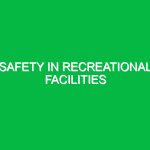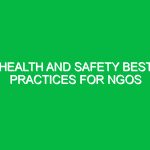Introduction
Safety Programs for Non-Profit Organizations are essential frameworks designed to protect the health and well-being of volunteers, staff, and the communities they serve. In the Health, Safety, and Environment (HSE) domain, these programs address a multitude of risks and hazards inherent in non-profit operations. Whether a non-profit organization is engaged in community service, disaster relief, or environmental advocacy, the imperative for a robust safety program cannot be overstated. This article delves deep into the components, hazards, best practices, and regulations surrounding safety programs tailored for non-profits.
Understanding Safety Programs for Non-Profit Organizations
At its core, a safety program is a proactive approach that encompasses policies, procedures, and practices aimed at minimizing risks and ensuring compliance with health and safety regulations. For non-profit organizations, this involves creating a culture of safety that not only adheres to legal standards but also prioritizes the well-being of all stakeholders involved. With limited resources, non-profits often face unique challenges in implementing these programs, making it crucial to identify efficient and effective strategies.
Identifying Potential Hazards and Risks
Non-profit organizations encounter a diverse array of hazards that can jeopardize safety. These hazards can be broadly categorized into physical, biological, ergonomic, and psychosocial risks. Understanding these risks is the first step toward developing an effective safety program.
1. Physical Hazards
Physical hazards are perhaps the most visible risks. They can include slips, trips, and falls, especially in community settings or during events. For instance, a non-profit organizing a community cleanup may face challenges related to uneven terrain or inclement weather. Additionally, non-profits that handle equipment, such as tools for construction or gardening, must ensure proper training and safety measures are in place to prevent accidents.
2. Biological Hazards
Biological risks are prominent in non-profits dealing with health care, social services, or environmental conservation. Exposure to pathogens, mold, or hazardous waste can pose significant risks. For example, a non-profit providing health services may encounter bloodborne pathogens, necessitating strict adherence to safety protocols, such as the use of personal protective equipment (PPE) and proper disposal methods for medical waste.
3. Ergonomic Hazards
Ergonomic hazards arise from poor workplace design or practices that strain the body. Non-profits that require physical labor, such as food banks or disaster response teams, are particularly vulnerable. Implementing ergonomic assessments and training can help mitigate these risks, ensuring that volunteers and staff maintain proper posture and avoid repetitive strain injuries.
4. Psychosocial Hazards
Psychosocial risks, including stress, harassment, and burnout, are often overlooked yet can have a debilitating impact on non-profit workers. The demanding nature of non-profit work can lead to emotional exhaustion. Organizations must foster an environment of support, provide access to mental health resources, and implement policies to address workplace bullying or harassment.
Safety Precautions and Best Practices
Once hazards are identified, the next step is to implement safety precautions and best practices. Here are several actionable strategies that non-profit organizations can adopt to enhance their safety programs.
1. Conduct Regular Risk Assessments
Regular risk assessments are vital for identifying potential hazards in the workplace. These assessments should involve staff and volunteers to gather diverse insights. A thorough analysis can reveal hidden risks and inform the development of effective safety strategies. For example, a non-profit working in disaster relief might conduct site assessments before deployment to ensure safety measures are in place.
2. Develop Comprehensive Training Programs
Training is the cornerstone of any successful safety program. Non-profits should develop comprehensive training modules that cover various aspects of safety, including first aid, emergency response, and specific hazard training. Engaging volunteers in interactive sessions not only enhances their skills but also fosters a culture of safety within the organization. An anecdote from a local shelter highlights how a first-aid training session empowered volunteers to confidently handle minor injuries during outreach events.
3. Implement Safety Policies and Procedures
Establishing clear safety policies and procedures is crucial. These documents should outline the organization’s commitment to safety and detail the steps individuals must follow in various scenarios. Policies should also address reporting procedures for accidents or near misses. By creating a culture of transparency, non-profits can encourage individuals to report hazards without fear of repercussions.
4. Foster Open Communication
Encouraging open communication about safety concerns is paramount. Non-profits should create channels for staff and volunteers to voice their concerns and suggestions regarding safety. Regular meetings to discuss safety topics can empower individuals to take ownership of their safety and that of their peers.
5. Utilize Technology
Technology plays an increasingly vital role in enhancing safety programs. Non-profits can leverage software for incident reporting, training management, and communication. For instance, using mobile apps can streamline the reporting of safety issues in real-time, ensuring prompt action is taken. A non-profit dedicated to environmental conservation successfully implemented a mobile platform, enabling volunteers to report hazards encountered during fieldwork, leading to improved safety measures.
Regulations and Standards Governing Safety Programs
Safety programs for non-profit organizations must comply with various regulations and standards. Understanding these legal requirements is essential to ensure the organization’s safety program is both effective and compliant.
1. Occupational Safety and Health Administration (OSHA)
OSHA is the primary regulatory body governing workplace safety in the United States. Non-profits must adhere to OSHA standards, which outline requirements for maintaining a safe work environment. This includes proper training, hazard communication, and record-keeping for workplace injuries.
2. State Regulations
In addition to federal regulations, non-profits must comply with state-specific safety laws. These regulations can vary significantly, so organizations should familiarize themselves with local requirements to ensure compliance.
3. Industry Standards
Non-profits may also need to adhere to industry-specific standards. For instance, organizations involved in healthcare must follow guidelines set by the Centers for Disease Control and Prevention (CDC) and the National Institute for Occupational Safety and Health (NIOSH). These standards provide frameworks for managing biological hazards and ensuring worker safety.
Conclusion
Safety Programs for Non-Profit Organizations are not merely a regulatory obligation; they are a moral imperative. By understanding potential hazards, implementing best practices, and complying with regulations, non-profits can create a safer environment for their volunteers, staff, and the communities they serve. A proactive approach to safety not only protects individuals but also enhances the organization’s reputation, fosters trust, and ultimately contributes to the success of their mission. Investing in safety is investing in the future of the non-profit sector.


